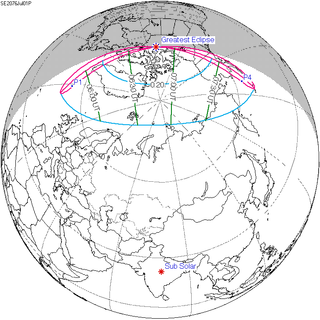
Summary
A partial solar eclipse will occur on Wednesday, July 1, 2076. A solar eclipse occurs when the Moon passes between Earth and the Sun, thereby totally or partly obscuring the image of the Sun for a viewer on Earth. A partial solar eclipse occurs in the polar regions of the Earth when the center of the Moon's shadow misses the Earth.
| Solar eclipse of July 1, 2076 | |
|---|---|
 Map | |
| Type of eclipse | |
| Nature | Partial |
| Gamma | 1.4005 |
| Magnitude | 0.2746 |
| Maximum eclipse | |
| Coordinates | 67°00′N 98°06′W / 67°N 98.1°W |
| Times (UTC) | |
| Greatest eclipse | 6:50:43 |
| References | |
| Saros | 157 (2 of 70) |
| Catalog # (SE5000) | 9678 |
Related eclipses edit
Solar eclipses 2073–2076 edit
This eclipse is a member of a semester series. An eclipse in a semester series of solar eclipses repeats approximately every 177 days and 4 hours (a semester) at alternating nodes of the Moon's orbit.[1]
| 122 | February 7, 2073 Partial |
127 | August 3, 2073 Total |
| 132 | January 27, 2074 Annular |
137 | July 24, 2074 Annular |
| 142 | January 16, 2075 Total |
147 | July 13, 2075 Annular |
| 152 | January 6, 2076 Total |
157 | July 1, 2076 Partial |
Metonic series edit
The metonic series repeats eclipses every 19 years (6939.69 days), lasting about 5 cycles. Eclipses occur in nearly the same calendar date. In addition, the octon subseries repeats 1/5 of that or every 3.8 years (1387.94 days). All eclipses in this table occur at the Moon's ascending node.
| 21 eclipse events, progressing from south to north between July 1, 2000 and July 1, 2076 | ||||
|---|---|---|---|---|
| July 1–2 | April 19–20 | February 5–7 | November 24–25 | September 12–13 |
| 117 | 119 | 121 | 123 | 125 |
| July 1, 2000 |
April 19, 2004 |
February 7, 2008 |
November 25, 2011 |
September 13, 2015 |
| 127 | 129 | 131 | 133 | 135 |
| July 2, 2019 |
April 20, 2023 |
February 6, 2027 |
November 25, 2030 |
September 12, 2034 |
| 137 | 139 | 141 | 143 | 145 |
| July 2, 2038 |
April 20, 2042 |
February 5, 2046 |
November 25, 2049 |
September 12, 2053 |
| 147 | 149 | 151 | 153 | 155 |
| July 1, 2057 |
April 20, 2061 |
February 5, 2065 |
November 24, 2068 |
September 12, 2072 |
| 157 | 159 | 161 | 163 | 165 |
| July 1, 2076 References edit
External links edit
| ||||


